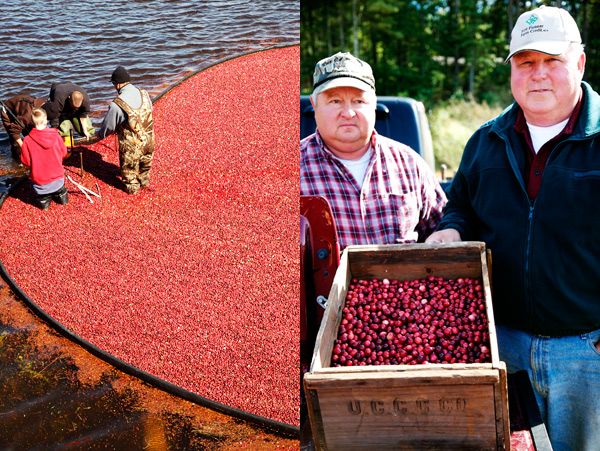|
|
Harvesting Cranberries In England, United Kingdom
|
"The Compleat Cook's Guide" published in 1683 made reference to cranberry juice. In 1703, cranberries were served at the Harvard University commencement dinner. In 1787, James Madison wrote Thomas Jefferson in France for background information on constitutional government to use at the Constitutional Convention. Jefferson sent back a number of books on the subject and in return asked for a gift of apples, pecans and cranberries. William Aiton,a Scottish botanist, included an entry for the cranberry in volume II of his 1789 work, Hortus Kewensis. He notes that Vaccinium macrocarpon (American cranberry) was cultivated by James Gordon in 1760. In 1796, cranberries were served at the first celebration of the landing of the Pilgrims, and Amelia Simmons (an American orphan) wrote a book entitled "American Cookery" which contained a recipe for cranberry tarts. In 1816, Henry Hall first commercially grew cranberries in East Dennis, Massachusetts on Cape Cod. In 1843, Eli Howes planted his own crop of cranberries on Cape Cod, using the "Howes" variety. In 1847, Cyrus Cahoon planted a crop of "Early Black" variety near Pleasant Lake, Harwich, Massachusetts. In 1860, Edward Watson, a friend of Henry David Thoreau wrote a poem called "The Cranberry Tart."
Cranberry sales in the United States have traditionally been associated with holidays of Thanksgiving and Christmas. Until the 1930s most of the crop was sold fresh.
In the U.S., large scale cranberry cultivation has been developed as opposed to other countries. American cranberry growers have a long history of cooperative marketing. As early as 1904, John Gaynor, a Wisconsin grower, and A.U. Chaney, a fruit broker from Des Moines, Iowa, organized Wisconsin growers into a cooperative called the Wisconsin Cranberry Sales Company to receive a uniform price from buyers. Growers in New Jersey and Massachusetts were also organized into cooperatives, creating the National Fruit Exchange that marketed fruit under the Eatmor brand. The success of cooperative marketing almost led to its failure. With consistent and high prices, area and production doubled between 1903 and 1917 and prices fell. In 1918, US$54,000 was spent on advertising, leading to US$1 million in increased sales.
With surplus cranberries and changing American households some enterprising growers began canning cranberries that were below-grade for fresh market. Competition between canners was fierce because profits were thin. The Ocean Spray cooperative was established in 1930 through a merger of three primary processing companies: Ocean Spray Preserving company, Makepeace Preserving Co, and Cranberry Products Co. The new company was called Cranberry Canners, Inc. and used the Ocean Spray label on their products. Since the new company represented over 90% of the market, it would have been illegal (cf. antitrust) had attorney John Quarles not found an exemption for agricultural cooperatives. As of 2006, about 65% of the North American industry belongs to the Ocean Spray cooperative. (The percentage may be slightly higher in Canada than in the U.S.)
|
|









